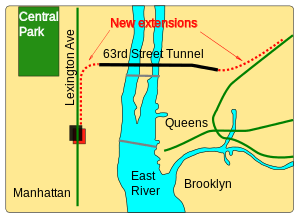63rd Street Tunnel
|
The 63rd Street Tunnel, in the context of the East Side Access project | |
| Overview | |
|---|---|
| Line | 63rd Street Line (F train) |
| Location | East River between Manhattan and Queens, New York City |
| Coordinates | 40°45′36″N 73°57′18″W / 40.76000°N 73.95500°WCoordinates: 40°45′36″N 73°57′18″W / 40.76000°N 73.95500°W |
| System |
New York City Subway LIRR (future) |
| Operation | |
| Opened | October 29, 1989 |
| Operator | Metropolitan Transportation Authority |
| Technical | |
| Length | 3,140 feet (960 m) between shafts[1] |
| No. of tracks | 2 |
| Width | 38.5 feet (11.7 m)[1][2] |
The 63rd Street Tunnel in New York City is a bi-level rail tunnel under the East River between Manhattan and Queens, passing through Roosevelt Island. It is the newest river crossing in the New York metropolitan area. Construction of the 63rd Street Tunnel began on November 24, 1969. The first section, from Manhattan to Roosevelt Island was completed on October 10, 1972.[3][4] The second section, extending to Queens, was completed in 1989, with a connector to the IND Queens Boulevard Line completed by 2000. Completion of the tunnel was delayed by New York City's fiscal crisis of the 1970s.
The tunnel currently carries the 63rd Street Line of the New York City Subway and will carry Long Island Rail Road trains following completion of the East Side Access project.
Construction method
Unlike previous tunnels that were bored under the riverbed, the 63rd Street Tunnel's river portions used the immersed tube method. Trenches were dug in the river bed, and four 375-foot (114 m) long prefabricated concrete sections of tunnel fabricated in Port Deposit, Maryland were floated into position and then sunk into the trenches.[2][5][6] Other portions of the tunnel were built using cut-and-cover construction or rock tunneling. The tunnel also contains the Roosevelt Island station.
Usage
The tunnel has two levels. The F train uses the two tracks on the upper level, connecting the IND Queens Boulevard Line in Queens to the IND Sixth Avenue Line in Manhattan via the IND 63rd Street Line. There are also track connections to and from the BMT 63rd Street Line, west of the Lexington Avenue – 63rd Street station.
Upper level
The tunnel was placed into partial service in 1989 and was nicknamed the "tunnel to nowhere" due to its lack of connections in Queens.[7][8] The final section of the 63rd Street Tunnel, which cost $645 million to complete and connects what had been a service dead-ending at the 21st Street station in Queensbridge to the IND Queens Boulevard Line, was finished in 2000. It was first used by trains during off-peak hours while signal work was performed in the 53rd Street Tunnel.[9][10] The tunnel connection was placed into permanent service with the start of V service and the rerouting of the F service on December 17, 2001.[11]
Lower level
The two trackways on the lower level are currently unused by trains, but are planned for use by the Long Island Rail Road's East Side Access project, which will bring LIRR commuter trains to Grand Central Terminal between 2019 and 2023. During construction of the East Side Access project, the lower level of the 63rd Street Tunnel is being used to transport equipment; excavated rock from Manhattan is also hauled out to Sunnyside Yard on a 5-mile (8.0 km) long conveyor belt.[8]
Awards
The 63rd Street Tunnel and the 63rd Street Tunnel Connector received the Construction Achievement Project of the Year Award from the Metropolitan Section of the American Society of Civil Engineers in 1973 and 2000, respectively.[12]
The 63rd Street Tunnel Connector was also selected as the Transit Project of the Year in 1999 by New York Construction News.[13]
- Vents
-
Tunnel vents in Central Park
-
63rd St Ventilating Tower, East of Second Ave
-
Ventilation structure on Roosevelt Island
-
Ventilator and emergency exit in Queensbridge park
References
- 1 2 Guide to Civil Engineering Projects In and Around New York City (2nd ed.). Metropolitan Section, American Society of Civil Engineers. 2009. pp. 62–63.
- 1 2 "63rd Street Tunnel" (PDF). International Tunneling and Underground Space Association. Retrieved October 16, 2011.
- ↑ Burks, Edward C. (November 25, 1969). "Mayor and Governor Unite to Start Transit Tube". The New York Times. Retrieved February 13, 2010.
- ↑ "Governor Rockefeller and Mayor Lindsay Attend 'Holing Through' of 63d St. Tunnel". The New York Times. October 11, 1972. Retrieved February 13, 2010.
- ↑ Cudahy, Brian J. (1979). Under the Sidewalks of New York: The Story of the Greatest Subway System in the World. Brattleboro, VT: S. Greene Press. p. 145. ISBN 0-8289-0352-2.
- ↑ Munfah, Nasri A.; Tarhan, Yalcin M. (1990). Immersed Tunnel Techniques: Proceedings of the Conference Organized by the Institution of Civil Engineers. London: Thomas Telford. p. 327. ISBN 0-7277-1512-7. Retrieved October 16, 2011.
- ↑ Lorch, Donatella (October 29, 1989). "The 'Subway to Nowhere' Now Goes Somewhere". The New York Times. Retrieved July 25, 2009.
- 1 2 Rumsey, Spencer (April 21, 2011). "Tunnel Vision: Inside the East Side Access Project". Long Island Press. Retrieved October 16, 2011.
- ↑ Saulny, Susan (November 28, 2000). "Another Tunnel Offers Breathing Room for E and F Trains". The New York Times. Retrieved February 13, 2010.
- ↑ Kennedy, Randy (November 28, 2001). "New Subway Line To Start". The New York Times. Retrieved February 13, 2010.
- ↑ Kershaw, Sarah (December 17, 2001). "V Train Begins Service Today, Giving Queens Commuters Another Option". The New York Times. Archived from the original on March 25, 2010. Retrieved February 13, 2010.
- ↑ "Construction Achievement Project of the Year Award". ASCE Metropolitan Section. Retrieved October 10, 2016.
- ↑ "Transit Project of the Year" (PDF). New York Construction News. December 1999. p. 47. Retrieved October 16, 2011.
